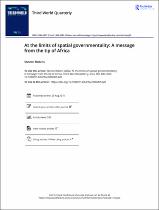| dc.description.abstract | Urban studies scholars drawing on Foucault’s analysis of govern-mentality have investigated how urban social orders are increasingly moreconcerned with the management of space rather than on the discipline ofoffenders or the punishment of offences (Merry, 2001). This paper examines the‘rationality’ and efficacy of spatial governmentality in post-apartheid CapeTown, and shows how the city has increasingly become a ‘fortress city’ (Davis,1990), much like cities such as Los Angeles, Sao Paolo and Rio de Janeiro. These‘global cities’ are increasingly characterised by privatised security systems inmiddle class suburbs, shopping malls and gated communities (Caldeira, 1999).These spatial forms of governmentality draw on sophisticated security systemscomprising razor wire and electrified walls, burglar alarms and safe rooms, aswell as vicious guard dogs, neighbourhood watches, private security companies,and automated surveillance cameras. | en_US |

